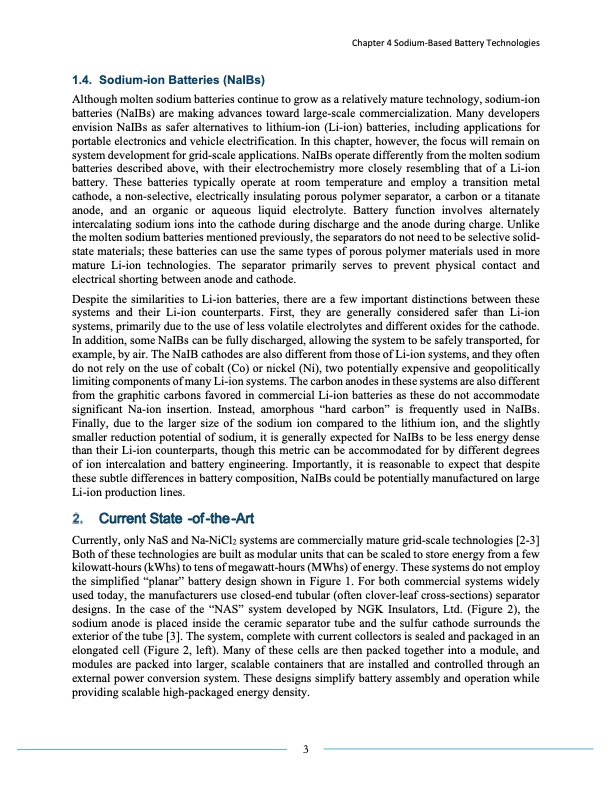
PDF Publication Title:
Text from PDF Page: 003
1.4. Sodium-ion Batteries (NaIBs) Although molten sodium batteries continue to grow as a relatively mature technology, sodium-ion batteries (NaIBs) are making advances toward large-scale commercialization. Many developers envision NaIBs as safer alternatives to lithium-ion (Li-ion) batteries, including applications for portable electronics and vehicle electrification. In this chapter, however, the focus will remain on system development for grid-scale applications. NaIBs operate differently from the molten sodium batteries described above, with their electrochemistry more closely resembling that of a Li-ion battery. These batteries typically operate at room temperature and employ a transition metal cathode, a non-selective, electrically insulating porous polymer separator, a carbon or a titanate anode, and an organic or aqueous liquid electrolyte. Battery function involves alternately intercalating sodium ions into the cathode during discharge and the anode during charge. Unlike the molten sodium batteries mentioned previously, the separators do not need to be selective solid- state materials; these batteries can use the same types of porous polymer materials used in more mature Li-ion technologies. The separator primarily serves to prevent physical contact and electrical shorting between anode and cathode. Despite the similarities to Li-ion batteries, there are a few important distinctions between these systems and their Li-ion counterparts. First, they are generally considered safer than Li-ion systems, primarily due to the use of less volatile electrolytes and different oxides for the cathode. In addition, some NaIBs can be fully discharged, allowing the system to be safely transported, for example, by air. The NaIB cathodes are also different from those of Li-ion systems, and they often do not rely on the use of cobalt (Co) or nickel (Ni), two potentially expensive and geopolitically limiting components of many Li-ion systems. The carbon anodes in these systems are also different from the graphitic carbons favored in commercial Li-ion batteries as these do not accommodate significant Na-ion insertion. Instead, amorphous “hard carbon” is frequently used in NaIBs. Finally, due to the larger size of the sodium ion compared to the lithium ion, and the slightly smaller reduction potential of sodium, it is generally expected for NaIBs to be less energy dense than their Li-ion counterparts, though this metric can be accommodated for by different degrees of ion intercalation and battery engineering. Importantly, it is reasonable to expect that despite these subtle differences in battery composition, NaIBs could be potentially manufactured on large Li-ion production lines. Current State -of-the-Art Currently, only NaS and Na-NiCl2 systems are commercially mature grid-scale technologies [2-3] Both of these technologies are built as modular units that can be scaled to store energy from a few kilowatt-hours (kWhs) to tens of megawatt-hours (MWhs) of energy. These systems do not employ the simplified “planar” battery design shown in Figure 1. For both commercial systems widely used today, the manufacturers use closed-end tubular (often clover-leaf cross-sections) separator designs. In the case of the “NAS” system developed by NGK Insulators, Ltd. (Figure 2), the sodium anode is placed inside the ceramic separator tube and the sulfur cathode surrounds the exterior of the tube [3]. The system, complete with current collectors is sealed and packaged in an elongated cell (Figure 2, left). Many of these cells are then packed together into a module, and modules are packed into larger, scalable containers that are installed and controlled through an external power conversion system. These designs simplify battery assembly and operation while providing scalable high-packaged energy density. 3 Chapter 4 Sodium-Based Battery TechnologiesPDF Image | SODIUM-BASED BATTERY TECHNOLOGIES CH 4

PDF Search Title:
SODIUM-BASED BATTERY TECHNOLOGIES CH 4Original File Name Searched:
ESHB_Ch4_Sodium_Spoerke-1.pdfDIY PDF Search: Google It | Yahoo | Bing
Salgenx Redox Flow Battery Technology: Salt water flow battery technology with low cost and great energy density that can be used for power storage and thermal storage. Let us de-risk your production using our license. Our aqueous flow battery is less cost than Tesla Megapack and available faster. Redox flow battery. No membrane needed like with Vanadium, or Bromine. Salgenx flow battery
| CONTACT TEL: 608-238-6001 Email: greg@salgenx.com | RSS | AMP |